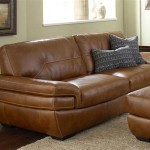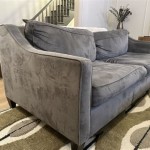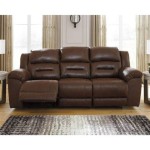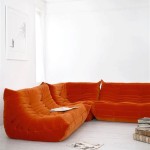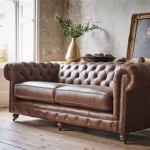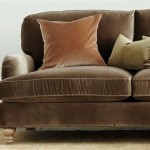Couch vs. Sofa vs. Divan: Understanding the Differences
The terms couch, sofa, and divan are often used interchangeably, leading to confusion about what distinguishes them. While they all serve the same primary function – providing seating and comfort – subtle differences in their design, structure, and historical context set them apart. This article aims to explore these distinctions, providing a comprehensive understanding of each type of furniture.
The lines between these terms have blurred over time, particularly with modern furniture designs that often incorporate elements from each. However, understanding the traditional characteristics of each piece remains valuable when considering style preferences, space limitations, and desired functionality.
Historically, each term has distinct origins and associations. The word "couch" has Anglo-Norman roots, while "sofa" derives from the Arabic word "suffah," referring to a raised platform. "Divan" also has Persian origins, originally denoting a council chamber or a long, cushioned seat.
Key Point 1: Defining the Couch
The term "couch" generally refers to a piece of furniture designed for lounging. Traditionally, couches were characterized by having arms and a back, making them suitable for both sitting and reclining. The height of the back and arms often varies, but they are essential components of its structure.
Couches are often associated with informal settings and are commonly found in living rooms, dens, or family rooms. The emphasis is usually on comfort and relaxation, with plush cushions and soft upholstery being common features.
The design of a couch can range from traditional to contemporary, with a wide variation in size and shape. Some couches feature rolled arms, tufted backs, and intricate detailing, while others have a more minimalist and streamlined aesthetic. The choice of materials also contributes to the overall style, with options ranging from durable fabrics like cotton and linen to luxurious materials like leather and velvet.
The purpose of a couch is to provide a comfortable and versatile seating option. It is a central piece of furniture in many homes, offering a space for relaxation, conversation, and entertainment. The structural integrity of a couch is also important, ensuring that it can withstand regular use and provide adequate support.
Modern couches often incorporate features such as reclining mechanisms, adjustable headrests, and built-in storage. These additions enhance the functionality and versatility of the couch, making it an even more appealing option for contemporary living spaces.
The construction of a couch typically involves a sturdy frame, usually made of wood or metal. This frame provides the foundation for the seating area and supports the cushions and upholstery. The suspension system, which can consist of springs, webbing, or a combination of both, provides additional support and comfort.
The cushions are typically filled with foam, feathers, or a combination of both. Foam cushions offer good support and are relatively easy to maintain, while feather cushions provide a softer and more luxurious feel. The upholstery is the final layer, providing both aesthetic appeal and protection to the underlying materials.
Key Point 2: Exploring the Sofa
The term "sofa" is often considered synonymous with "couch," but historically, it referred to a more formal and elaborate piece of furniture. Sofas traditionally featured a fully upholstered frame, including the back and arms, and were often more ornate in design than couches.
Sofas were commonly found in parlors or drawing rooms, spaces dedicated to entertaining guests and showcasing the homeowner's wealth and status. As such, sofas were often crafted from high-quality materials and adorned with intricate details.
The design of a sofa can vary widely, ranging from classic styles like the Chesterfield with its deep button tufting and rolled arms to more modern and minimalist designs. The size of a sofa is also a key consideration, ranging from loveseats designed for two people to large sectional sofas that can accommodate entire families.
The upholstery of a sofa is a crucial element, contributing to its overall aesthetic and durability. Common upholstery materials include leather, velvet, linen, and various synthetic fabrics. Each material offers different advantages in terms of appearance, comfort, and maintenance.
The construction of a sofa is similar to that of a couch, involving a sturdy frame, a suspension system, and comfortable cushions. However, sofas often feature more intricate detailing and higher-quality materials, reflecting their historical association with formal settings.
Modern sofas often incorporate technological advancements, such as built-in charging ports, adjustable headrests, and integrated entertainment systems. These features enhance the functionality and convenience of the sofa, making it a valuable addition to contemporary living spaces.
The seating arrangement of a sofa can also vary, with options ranging from traditional three-seater sofas to corner sofas and modular sofas that can be configured to suit different spatial requirements. The choice of seating arrangement depends on the size of the room and the desired functionality of the sofa.
Key Point 3: Understanding the Divan
The term "divan" has its origins in Persian culture, where it referred to a long, low seat or platform typically placed along a wall and covered with cushions. Unlike couches and sofas, divans traditionally lacked a back and arms, although modern interpretations may feature partial or adjustable supports.
Divans were often used for lounging and relaxation, creating a comfortable and informal seating area. They were commonly found in homes and harems, providing a space for socializing, reading, and resting.
The design of a divan is typically simple and minimalist, emphasizing comfort and functionality. The focus is on providing a soft and supportive seating surface, with cushions and pillows playing a key role in enhancing comfort. The absence of a back and arms allows for greater flexibility in terms of posture and seating arrangement.
The upholstery of a divan can vary widely, ranging from traditional fabrics like silk and velvet to more modern materials like cotton and linen. The choice of upholstery depends on the desired aesthetic and the level of comfort required.
The construction of a divan is typically simpler than that of a couch or sofa, consisting of a sturdy platform or frame covered with padding and upholstery. The cushions and pillows are often arranged to provide back support and enhance comfort.
Modern divans may incorporate features such as adjustable backrests, storage compartments, and integrated lighting. These additions enhance the functionality and versatility of the divan, making it a suitable option for contemporary living spaces.
The placement of a divan can vary depending on the room and the desired aesthetic. Divans are often placed against walls, creating a cozy and inviting seating area. They can also be used as standalone pieces, providing a flexible and versatile seating option.
The key difference between a divan and a couch or sofa lies in its lack of a traditional back and arms. This design allows for greater flexibility and informality, making the divan a popular choice for those seeking a relaxed and comfortable seating option.
In summary, while the terms couch, sofa, and divan are often used interchangeably, understanding their historical origins and design characteristics can help in making informed decisions when choosing furniture. Each piece offers unique advantages in terms of style, comfort, and functionality, allowing individuals to select the option that best suits their needs and preferences.
The evolution of furniture design continues to blur the lines between these terms, leading to hybrid pieces that incorporate elements from each. However, the fundamental differences in their structure and purpose remain relevant, providing a framework for understanding the nuances of seating arrangements.

Sofa Or Couch Quick And Dirty Tips

Sofa Vs Couch Which One Is Better Love My Beds

What Is A Divan

What S The Difference Between A Chaise Divan Daybed Settee

Sofa Couch Or Divan

What Is A Divan

Q A Couch Vs Sofa Lounge N Writers Centre

What Is A Divan

The Er Rum Cartoon Couch Sofa Davenport Chesterfield Settee Or Divan

Sofa Vs Couch Main Differences Why Both Are Used Home Of Cozy
Related Posts

